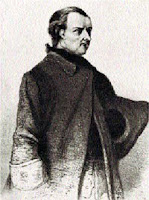 Cormac McCarthy's No Country for Old Men is driven by the taut language of the thriller, which stops to provide details only when it comes to machines and armaments:
Cormac McCarthy's No Country for Old Men is driven by the taut language of the thriller, which stops to provide details only when it comes to machines and armaments:The dead man was lying against a rock with a nickel-plated government .45 automatic lying cocked in the grass between his legs. He'd been sitting up and had slid over sideways. His eyes were open. He looked like he was studying something small in the grass. There was blood on the ground and blood on the rock behind him. (17)This laconic style suits the landscape in which it is set: the deserts, highways, and motels of Texas bordering on Mexico. It seems to be a wide-open land of big skies and long distances. In fact, this very openness means that there are few places a man can hide.
The novel's plot is suitably skeletal. A drug deal has gone wrong, and a Vietnam vet by the name of Llewellyn Moss, out hunting antelope, comes across the wreckage: bodies, abandoned cars, packages of heroin, and a briefcase packed with several million dollars in used hundred-dollar bills. Moss takes off with the cash, and soon enough just about everyone is after him: Mexican drug gangs, a fearsome contract killer, and the local police. The ensuing chase criss-crosses these dusty badlands, and takes Moss over the border to Mexico, where he gains brief respite in the local hospital having thrown the cash-laden case over the side of the border bridge. But from the start Moss seems to be aware that all his efforts will be in vain. This is not a story with a happy ending.
Interspersed through the narrative are the melancholic and world-weary commentaries of the sheriff who's always one or two steps behind the bloody action. Ed Tom Bell is also a military veteran, but of the Second World War not Vietnam. Close to retirement, Bell laments the changes that he has seen over his years of service, and laments his inability to prevent the trail of destruction that is snaking through his territory. Indeed, the novel's opening vignette sees a captured criminal strangle one of Bell's deputies with his own handcuffs and then calmly walk away. Perhaps then it's for the best that there is no climactic confrontation between the forces of law and order and the killers that they are ostensibly out to stop. As Bell notes,
I think for me the worst of it is knowing that probably the only reason I'm even still alive is that they have no respect for me. And that's very painful. Very painful. It has done got way beyond anything you might have thought about even a few years ago. (217)But the sheriff's irrelevance is such that even his semi-philosophical musings are, in the end, far off the mark. He complains about the young with their "green hair and bones in their noses speakin a language [their grandparents] couldnt even understand" (295), but these grouches about youth fashion hardly touch on the real evil that McCarthy has let loose at the center of his novel.
Indeed, ultimately we learn very little about the contract killer, Anton Chigurh, who is the book's true anti-hero. As Bell notes, "the reason nobody knows what he looks like is that they dont none of them live long enough to tell it" (192). At one point, as Chigurh finishes off his final (and apparently superfluous) assassination, McCarthy appears to suggest that this human killing machine simply obeys a higher order of principle and morality, more in tune with the way of the world and the brutal dictates of fate: "I have only one way to live. It doesn't allow for special cases. A coin toss perhaps" (259).
But in this landscape in which only the powerless speak, indeed in which speaking is an indication of impotence, this brief attempt to ventriloquize power is unconvincing. For McCarthy, power is violence and violence is, quite literally, unspeakable. He has conjured up a monster, or rather a personification of his view of nature as monstruous, about which he finally has nothing to say. He merely points: Look, while you can, through this novel, at an image that in life would leave you for dead.





















